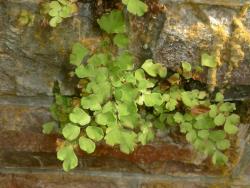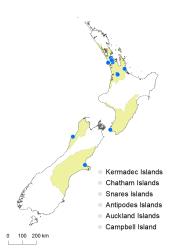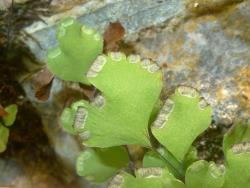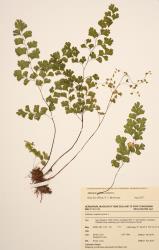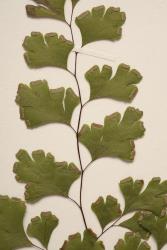- = Adiantum affine Willd., Sp. Pl. 5(1), 448 (1810)
Rhizomes short-creeping, up to 60 mm long (in herbarium specimens), 2–3 mm diameter, with stipes closely inserted; bearing scales; stolons and tubers absent. Rhizome scales narrowly ovate, 2–3.5 mm long, 0.2–0.4 mm wide, orange-brown, concolorous. Fronds 40–435 mm long. Stipes 20–210 mm long, dark brown, polished, glabrous except for a few scattered scales proximally. Rachises dark brown, sulcate, polished, glabrous. Laminae usually 2-pinnate, rarely 1-pinnate in very small fronds or 3-pinnate in large fronds, ovate, 20–270 mm long, 14–165 mm wide, mid-green on both surfaces, herbaceous, glabrous. 1–8 pairs of divided primary pinnae below pinnate apex, widely spaced especially proximally, ovate; the longest at or near the base, 8–115 mm long, 7–50 mm wide, apices obtuse, bases stalked, usually divided into secondary pinnae except in very small fronds. Longest secondary pinnae flabellate, 5–36 mm long, 5–16 mm wide, apices obtuse or rounded, margins deeply incised in largest fronds, or rarely divided into 1–3 tertiary pinnae, bases stalked, with stalks attached centrally. Reflexed lamina flaps oblong, extending laterally up to 5 mm, glabrous.
Adiantum capillus-veneris is distinguished by its usually 2-pinnate fronds, flabellate ultimate segments with the stalks attached centrally, glabrous rachises and laminae, oblong and glabrous “indusia”, and green abaxial lamina surface. The oblong or elongated reflexed lamina flaps distinguish this species from all other species of Adiantum in New Zealand.
North Island: Auckland, Southern North Island.
South Island: Western Nelson, Canterbury.
Altitudinal range: 0–140 m.
Adiantum capillus-veneris has been recorded from urban sites in Auckland, Waihi, Hamilton, Wellington, Westport and Christchurch.
Occurs naturally in tropical and temperate areas of North and South America, Europe, Asia, Africa, Australia and Hawai‘i. Its status in other Pacific islands is uncertain due to confusion with A. tenerum Sw.
Adiantum capillus-veneris grows most commonly on brick or concrete walls in urban areas, or occasionally on road or trackside banks, or on scoria.
Brownsey (1981). Voucher CHR 366041, 1978.
Tindale (1960) treated Willdenow’s Adiantum affine as a new species (although the illegitimate A. trapeziforme G.Forst. was cited), with a holotype from Willdenow’s herbarium (B-W 20093 -01 0). As pointed out by Tindale (1960) and Nicolson & Fosberg (2003), the holotype of A. affine is a specimen of A. capillus-veneris. The specimen is said to be from New Zealand, which is also the only locality given in Willdenow’s protologue. However, it is extremely unlikely that A. capillus-veneris was present in New Zealand at the time of Cook’s second voyage, and hence it must be concluded that the provenance of Willdenow’s specimen was somehow confused. The name A. affine was widely used in earlier New Zealand Floras for the plant now known as A. cunninghamii.



